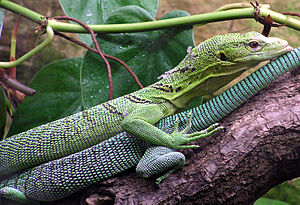Emerald monitor
| Emerald monitor | ||||||||||||
|---|---|---|---|---|---|---|---|---|---|---|---|---|

Emerald monitor ( Varanus prasinus ) |
||||||||||||
| Systematics | ||||||||||||
|
||||||||||||
| Scientific name | ||||||||||||
| Varanus prasinus | ||||||||||||
| ( Schlegel , 1839) |
The emerald monitor ( Varanus prasinus ) is a species of scale reptiles (Squamata) from the genus of monitor lizards . The lizard, which is native to the New Guinea rainforest, lives in trees, uses its thin, flexible prehensile tail as a climbing aid and feeds on insects and small mammals.
features
The longest specimen measured had a total length of 84.5 cm with a head-torso length of 29.5 cm, a total length of about 70 cm is normal. The tail length is 1.75 times the head-trunk length. The muzzle is long and pointed, the head short, the tummy scales keeled for extra support when climbing. The tail is round in cross-section and, like many closely related species, a long, thin grasping organ that is used when climbing. The claws are very sharp for their size, the limbs are comparatively long.
The basic color is generally a bright green, which is sometimes interrupted by irregularly arranged, dark bands. The underside of the body is whitish, yellowish or greenish. The emerald monitor differs from almost all other species of the V. prasinus group by its bright green color; it can be distinguished from the similarly colored V. telenesetes by the lack of a pattern on the throat.
distribution and habitat
The emerald monitor lives in large parts of New Guinea and some offshore islands such as Salawati and Boigu ( Torres Strait ). It lives in monsoon forests, rainforests, palm forests, mangroves and cocoa plantations up to 830 m above sea level.
Way of life
The emerald monitor dwells on trees and like all monitor lizards is diurnal and solitary. He climbs very slowly with the help of the grasping tail. The species feeds mainly on small insects, arachnids, centipedes and rodents. The rodents, which can weigh up to 40 g, are grabbed by the neck, repeatedly hit on the ground, scratched with the claws and swallowed head first. The prey is sought both in the trees and on the ground.
Little is known about the reproduction of the emerald monitor in nature. In the wild, the eggs are apparently laid in termite nests, the young have only been observed in October and apparently feed on termites and their eggs for some time after they hatch.
Systematics
Within the genus Varanus , the emerald monitor is placed in the subgenus Euprepiosaurus , where it is the nominate form and member of the V. prasinus group; this group forms the sister taxon to the V. indicus group.
For a long time, numerous subspecies were assigned to the emerald monitor, meanwhile all former subspecies have been raised to species status. The Varanus beccarii , Varanus bogerti and Varanus kordensis , which were temporarily listed as subspecies in the past , are now generally listed as separate species, but the taxonomy in the V. prasinus complex remains very dubious and needs to be revised.
swell
- Greene, HW (2004): Varanus prasinus . In: ER Pianka & DR King (Eds.): Varanoid Lizards of the World , pp. 225-229. Indiana University Press, Bloomington & Indianapolis. ISBN 0253343666
- Rogner, M. (1994): Echsen 2 , p. 29. Eugen Ulmer Verlag, Stuttgart. ISBN 3-8001-7253-4
- ↑ a b c d e f g h according to Greene (2004)
- ↑ a b c according to Rogner (1994)
- ↑ a b c Ziegler, T .; A. Schmitz, A. Koch & W. Böhme (2007): A review of the subgenus Euprepiosaurus of Varanus (Squamata: Varanidae): Morphological and molecular phylogeny, distribution and zoogeography, with an identification key for the members of the V. indicus and the V. prasinus species groups . Zootaxa 1472, pp. 1-28
- ^ Clarke, RH (2005): A record of the Emerald Monitor Varanus prasinus from Boigu Island, Torres Strait, Australia . Herpetofauna 34 (2), pp. 70-71
- ↑ Pattiselanno, F .; E. Rahayu & J. Wanggai (2007): Varanus Species at The Arfak Strict Nature Reserve . Biodiversitas 8 (1), pp. 114-117